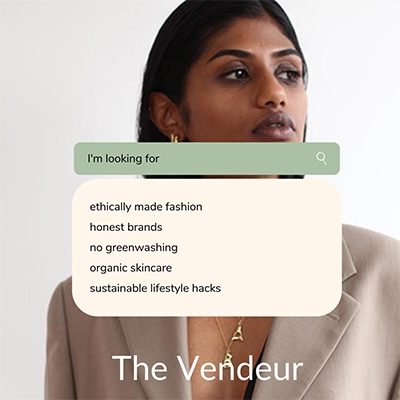10 Questions for Joe Metcalfe & Poppy Beer of Thrift+
All Images: Thrift+
Resale is booming, and so is the charity sector. Thrift+ are modernising charity shopping for those looking to enjoy thrifted and second hand fashion gems.
It’s no secret that the resale industry is enjoying a boom. (You can explore our favourite Resale websites too and read our recent article about Schwap founder Kalkidan Legesse.) As circularity becomes the new buzzword in sustainability, simply throwing away or recycling our clothes no longer cuts the mustard. Charity shops have shed their embarrassing, dusty image and shopping second hand or thrifting is now a coveted and acceptable way to shop. While companies like Depop may be making the most of Gen Z’s love for all things 90’s, there are several companies addressing the need for access to high street and designer cast offs.
One such company is Thrift+ which is revolutionising the way we shop for second hand. Having experienced working with charity shops previously, founder Joe Metcalfe wanted to streamline the service, and make preloved fashion available online. Although he encountered a lot of obstacles, Joe looked to tech to ensure that Thrift+ is able to process hundreds of thousands of items, sorting, photographing and listing them online. With around 30% of our wardrobe going unworn, it’s no wonder the level of inventory is high. Shoppers can see which charity benefits from their purchase and soon, Thrift+ will also people to shop by charity to ensure they choose a charity that suits them.
We spoke to co-founders Joe Metcalfe and Poppy Beer about the behind the scenes work that goes into processing and selling second hand fashion on such a huge scale.
The Vendeur: Tell us about your previous venture Charity Street and how it helped you to better understand the second hand / charity shop model in the UK?
Joe Metcalfe: While working as a business consultant, I started thinking about how e-commerce was growing rapidly, yet charity shops were still predominantly bricks and mortar. I wanted to find a way for charity shops to reach a wider audience, providing an easy service that would help get more second-hand clothes online. Charity Street was the first Click and Collect app for high street charity shops. Our service required charity shop volunteers to take photos of the best items, upload them, and monitor sales, readying them for collection. An important insight was that these busy volunteers didn’t have the time to manage this process, which got me thinking about other business models that might work.
TV: What did you believe was missing from current solutions that led you to see a gap in the market for Thrift+?
JM: While some people are happy to take their clothes to a local charity shop, I realised there was a huge opportunity to get more people to donate or re-sell their clothes for the first time. I believed that by making the process simpler and more rewarding, more people would do it. A third of our wardrobes are never worn, and providing an on-demand, easy service helps get them out of cupboards and back into circulation. Thrift+ offers a very simple service. You order a bioplastic, reusable ThriftBag (made from sugar cane), fill it up, and return for free. Our Thrifters do all the processing, photography and shipping, which attracts a new audience who would never spend time uploading individual items and selling them online. When our sellers earn credits to spend, redeem or donate, they have the option to support a wider range of charities, not just those that have a high street presence.
Enjoying this article?
Then you'll love our Newsletters. At the beginning of each month, we send you the low down for the month ahead, featuring news and our favourite responsible products and brands you need to know about. And whats more, you receive all of this direct to your inbox before anyone else.
TV: How has your previous experience in very different careers helped you to grow Thrift+?
JM: I used to work on a variety of projects which helped me to be versatile and look at problems from several angles. Nothing truly prepares you for starting your own business though – it’s a cliche but it really is a rollercoaster!
TV: How does tech play a part in allowing Thrift+ to process the huge amount of items you do?
JM: We have an app in our warehouse which enables our Thrifters to rapidly upload clothing details and photos when they are being processed. We also have an automated pricing tool which sets prices in line with the market, and 20 photography booths which allow us to take consistent photos every time. We also have our own app which allows people to scan their ThriftBag’s QR code to register it and decide their charity and how much they want to donate.
TV: What is a common misconception that people have about the work that you do?
JM: One thing that is hard to see from the outside is the complexity of processing thousands of individual, unique items. The process has to be accurate but as efficient as possible. Having such a diverse and large inventory (200,000+ items!) has many consequences. For instance, you can’t have photography in the same way you would with a collection where there are 1000s of the same thing. People are used to shopping with model shots, but that is difficult for us to provide.
TV: How does the sorting and assessing of the clothing work?
JM: When items arrive, they are quality assessed and tagged. Anything that doesn’t meet our standards for cleanliness, branding, or condition goes into a separate pile. Accepted clothes and accessories are then photographed, and have their details added to our system by a Thrifter. They are then uploaded. We upload around 35,000 new items every week.
TV: What happens to pieces that don’t make the cut?
JM: Anything that doesn’t pass our quality assessment is passed to charity retailers like Oxfam and Barnardo’s.
TV: How are you incorporating ethics into the company?
JM: Creating a circular fashion economy is at the core of what we do, and we are very mindful of our environmental impact beyond just extending the life of clothes. For example, our warehouse is solar powered which means that our energy footprint is very low. We also pay everyone in our warehouse over the Living Wage, and work hard to create an inclusive culture which sees mental health in the same way as physical health. Anyone can take a ‘Wellbeing Day’ at any time if they feel they need to, with no questions asked.
TV: How have you seen appetites for second hand clothing change since you first started in the industry?
JM: Second-hand fashion is definitely on the rise, and set to overtake sales of new by 2030. Many of the traditional barriers to second-hand clothes, like concerns about quality, are things we have actively addressed, such as by offering 30 day returns and a quality guarantee. Recently, we’ve found demand for second-hand clothing has boomed – the vast majority of people are environmentally conscious, and second-hand shopping has become ‘cool.’
TV: What do you think is the future of the second hand industry?
JM: I expect to see the percentage of second-hand, rented, or swapped clothes in our wardrobes grow. The whole fashion industry is moving towards circularity which is very exciting and will help lower fashion’s footprint from today’s staggering 10% of annual greenhouse gas emissions. In the future, we imagine a circular fashion subscription which allows you to re-sell and rent clothes on an ongoing basis, clearing out your wardrobe and hiring/buying new second-hand pieces every 2-3 months.
Did This Put A Smile On Your Face? Why Not Subscribe?
If you enjoyed this then theres plenty more on our email newsletters that you'll love. Whether you're a sustainable newbie or an eco conscious pro, our bi monthly emails will inspire you to live sustainably and ethically.
Disclaimer: The people and models in the images featured are not associated with The Vendeur and do not endorse it or the products shown. This post may contain affiliate links. Prices correct at time of publishing.









